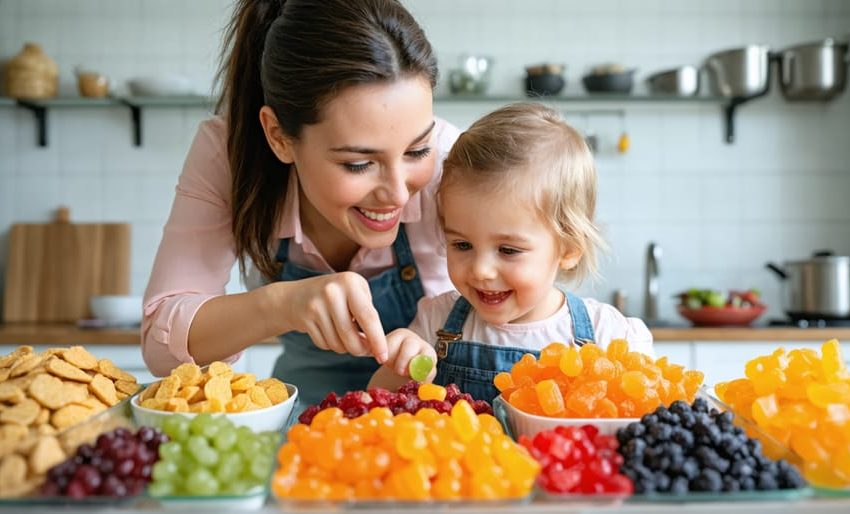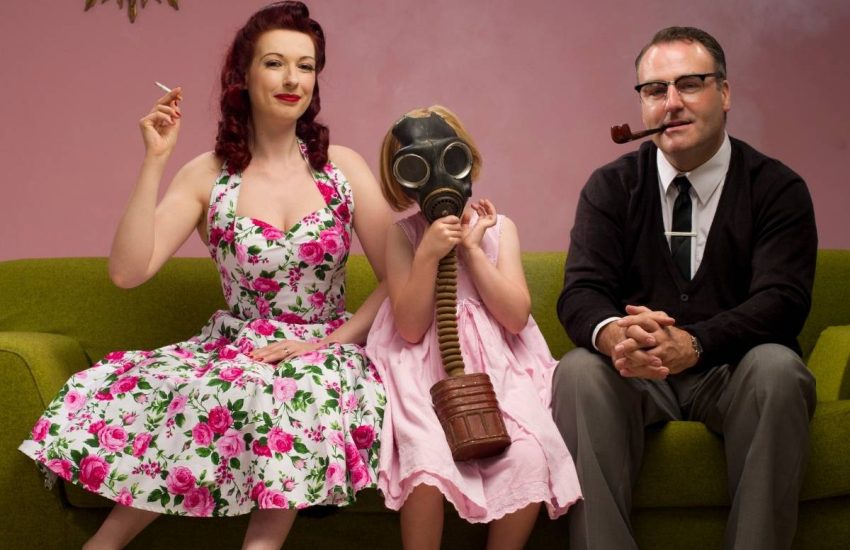Vaping and Parenting: Unseen Risks That Every Parent Should Know
laval vaping goods offers resources to educate yourself on the health risks associated with secondhand vapor exposure for children, helping you better understand the ingredients of what you use. Protect your children by ensuring that your home environment is vape-free. Avoid vaping indoors, especially in shared family spaces, and designate outdoor areas as the only acceptable vaping zones. Store vaping devices and liquids securely out of children’s reach, as they often contain high levels of nicotine, posing serious poisoning risks. Engage in open conversations about vaping risks with your family, emphasizing the importance of healthy lifestyle choices and setting a good example by seeking support if needed to quit vaping altogether.
Understanding Vaping: A Brief Overview
Vaping is a method of inhaling nicotine or other substances through an electronic device known as an e-cigarette. These devices work by heating a liquid—often containing nicotine, flavorings, and other chemicals—into a vapor that users then breathe in. This vapor can sometimes be confused with smoke, but it is different in composition, lacking the tar found in traditional cigarettes.
The rise in vaping’s popularity can be attributed to its portrayal as a safer alternative to smoking cigarettes, due to the absence of many harmful substances found in tobacco smoke. Many adults find vaping attractive because it comes in a variety of flavors and is generally more discreet, leading to perceptions of it being a less intrusive habit. Additionally, vaping is often viewed as a tool for smoking cessation, allowing individuals to gradually reduce their nicotine intake.
Despite its popularity, it’s essential for parents and caregivers to understand the potential risks associated with vaping, especially when children are around. The presence of harmful chemicals in vapor and the potential for secondhand exposure are crucial considerations for those raising families. Parenting is all about creating a safe and healthy environment for children, and understanding activities like vaping plays a significant role in that.
As vaping continues to grow in popularity, staying informed about its implications is important. It’s crucial, especially for parents, to weigh these factors when making household decisions that might impact their children’s well-being.
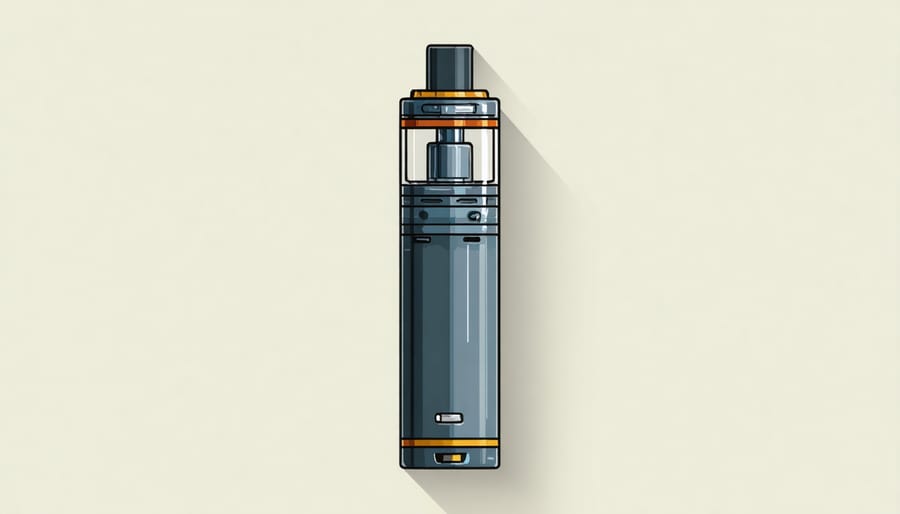
Health Risks of Vaping Around Children
Secondhand Vapor: What Parents Should Know
When you think about vaping, the risks to children might not immediately come to mind, but it’s important to know what secondhand vapor entails. Secondhand vapor, often misunderstood as harmless, contains harmful substances like nicotine, volatile organic compounds, and tiny particles that can be inhaled into the lungs. For children, exposure to these can be particularly dangerous. Kids’ bodies are still developing, making them more susceptible to health risks. Breathing in secondhand vapor could exacerbate asthma symptoms or lead to respiratory infections. It may even affect their long-term lung development and function. As a parent or caregiver, being informed and cautious about vaping around children can make a significant difference to their health. Taking steps to minimize their exposure to these risks, such as keeping vaping devices out of reach and avoiding vaping indoors or in confined spaces, can help protect them. Creating a safe and healthy environment is always the priority.
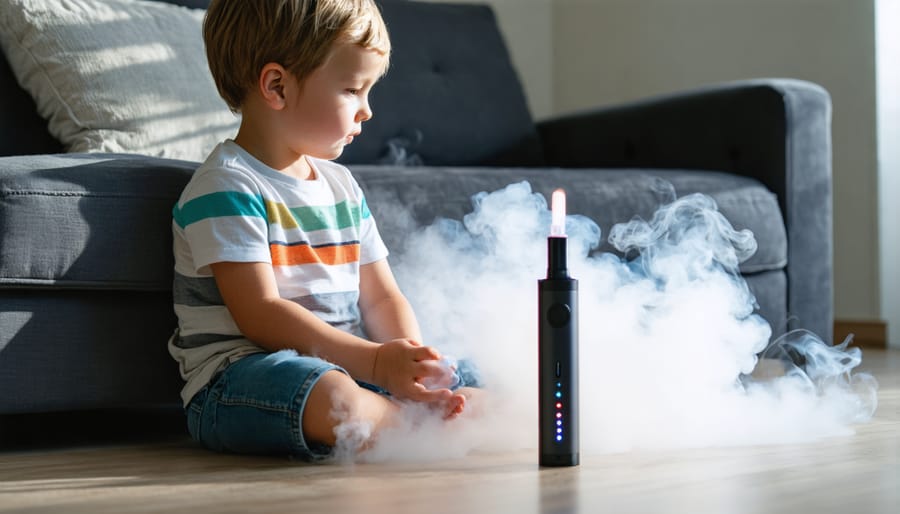
Long-term Health Implications
When considering the long-term health implications of vaping in a home environment where children are present, it’s crucial to understand how exposure to vapor can affect your little ones. Vaping releases aerosols that may contain harmful substances such as nicotine, which is particularly concerning as it can impact brain development in children. Kids are more vulnerable to these chemicals because their bodies are still growing, potentially leading to respiratory issues later in life. Studies suggest that children exposed to vaping may have an increased risk of developing conditions like asthma or chronic bronchitis.
Furthermore, the presence of vaping around children can inadvertently normalize this behavior, affecting their attitudes towards substances as they grow. It’s essential for parents and caregivers to be mindful of these risks, ensuring that their home environment is as safe and healthy as possible. By understanding these long-term effects, parents can make informed decisions to foster a healthier future for their children.
Impact on Parenting and Family Dynamics
Role Modeling: The Influence of Parents’ Habits
Children naturally look up to their parents, often imitating their actions and habits. This is why parents who vape should be aware of the influence their behavior can have on their kids. When children see their parents using vaping devices, they might perceive it as a harmless or acceptable activity, despite the health risks involved. Setting a positive example means showcasing healthy habits that you’d want your children to emulate. It’s crucial for parents to have open conversations with their kids about the potential dangers of vaping and why it’s important to avoid it. Creating a smoke-free and vape-free environment at home can reinforce these messages and encourage children to make healthier choices as they grow. Remember, the habits you display can have long-lasting impacts on your child’s perception of what’s normal and acceptable. By leading with mindfulness and transparency, parents can help guide their children toward a safer and healthier future.
Communication Challenges
Navigating conversations about vaping with older children can indeed be a challenge for many parents. Kids are naturally curious, and as they grow, they’re likely to encounter vaping in various social settings, perhaps even among their peers. It’s important to approach this topic with openness, creating a safe space where your child feels comfortable discussing their questions or concerns. Begin by explaining what vaping is, using simple language to clarify its distinctions from traditional smoking. Highlight health risks in a way that resonates with their understanding, such as discussing how vaping may impact lung health or overall well-being.
Remember, being judgment-free encourages more honest dialogue. Share your values and concerns without sounding overly critical, and listen actively to your child’s thoughts or experiences. This is also a good opportunity to set clear family expectations about vaping and substance use. Reinforce positive behavior and decision-making by providing facts and encouraging critical thinking, helping them navigate peer pressure. By maintaining ongoing conversations, you empower your child to make informed choices while strengthening your relationship.
Vaping around kids is a topic of great importance, and understanding its nuances can aid in fruitful discussions with your children.
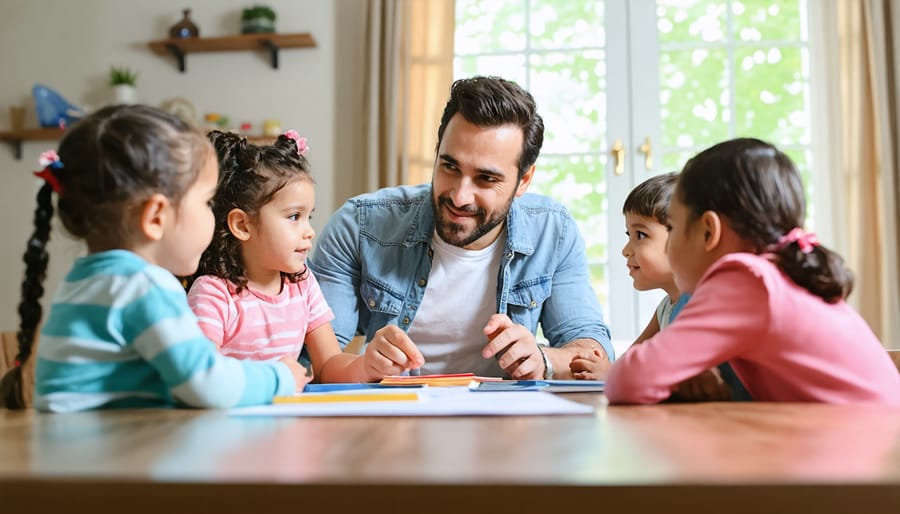
Creating a Safe Environment: Tips for Parents
Creating a safe environment is crucial for parents who want to protect their family from the risks associated with vaping. Start by having open conversations with your children about vaping, using simple and clear language that they can understand. Explain the health risks in a way that aligns with their level of comprehension, and reassure them that your primary goal is to keep them safe and healthy.
It’s equally important to set a good example by maintaining a vape-free home. If you or someone in your household vapes, consider quitting or finding ways to do it away from your family’s living areas. This not only reduces exposure but also models healthy behavior for your children. If you need support, plenty of resources are available to help you quit, ensuring a stronger and safer environment for your family.
Another practical step is making sure all vaping devices and supplies, such as e-juice bottles, are kept out of reach of children. This is critical for preventing accidental ingestion or other accidents. Regularly checking up on the accessibility of these items can reinforce safety.
Encouraging family activities that promote well-being and enhance your bond can also fortify a supportive atmosphere. Engaging in outdoor activities, playing games, or simply spending quality time together can strengthen family dynamics and redirect focus away from harmful habits.
Lastly, keep updated with the latest information about vaping risks to provide your children with relevant knowledge. Sharing age-appropriate news or information can empower them to make informed choices. By integrating these strategies, you create not only a safer environment but also a nurturing space where your family can thrive.
Resources and Support for Concerned Parents
Being a parent is a challenging journey, and dealing with the risks of vaping can add another layer of concern. Thankfully, there are numerous resources and support systems available to help you navigate these challenges. Consider reaching out to local health organizations that offer support groups for quitting vaping, as they provide a judgment-free zone to share experiences and strategies. Your family doctor can also guide you to professional counseling services specializing in addiction. Online resources, such as Smokefree.gov, provide tools and tips tailored to help parents quit vaping and maintain a smoke-free home environment. For families seeking financial support, community health centers often have programs that offer free or low-cost resources. Libraries can also be a treasure trove of information, offering books and workshops aimed at helping you raise emotionally smart kids. Remember, tackling vaping positively can set an empowering example for your children, showing resilience and the importance of making healthy choices for the family.
Conclusion
In conclusion, understanding the risks associated with vaping is crucial for parents aiming to create a safe environment for their children. Throughout this article, we’ve highlighted how vaping can inadvertently affect the health and well-being of families, exposing them to harmful chemicals even in seemingly innocuous settings. The potential impacts on respiratory health and the risk of nicotine dependency underscore the need for cautious decision-making. Embracing open conversations about these risks within your family can empower you and your children to make informed choices. Remember, creating a nurturing setting extends beyond physical safety—it involves proactive and ongoing awareness of emerging health concerns. By staying informed and engaged, parents can better protect their family’s health and well-being. If you’re looking for more information or resources, consider exploring our other articles, which delve deeper into children’s health and parenting advice. Your proactive stance on educating yourself as a parent strengthens your ability to navigate the complexities of parenting in modern times.


